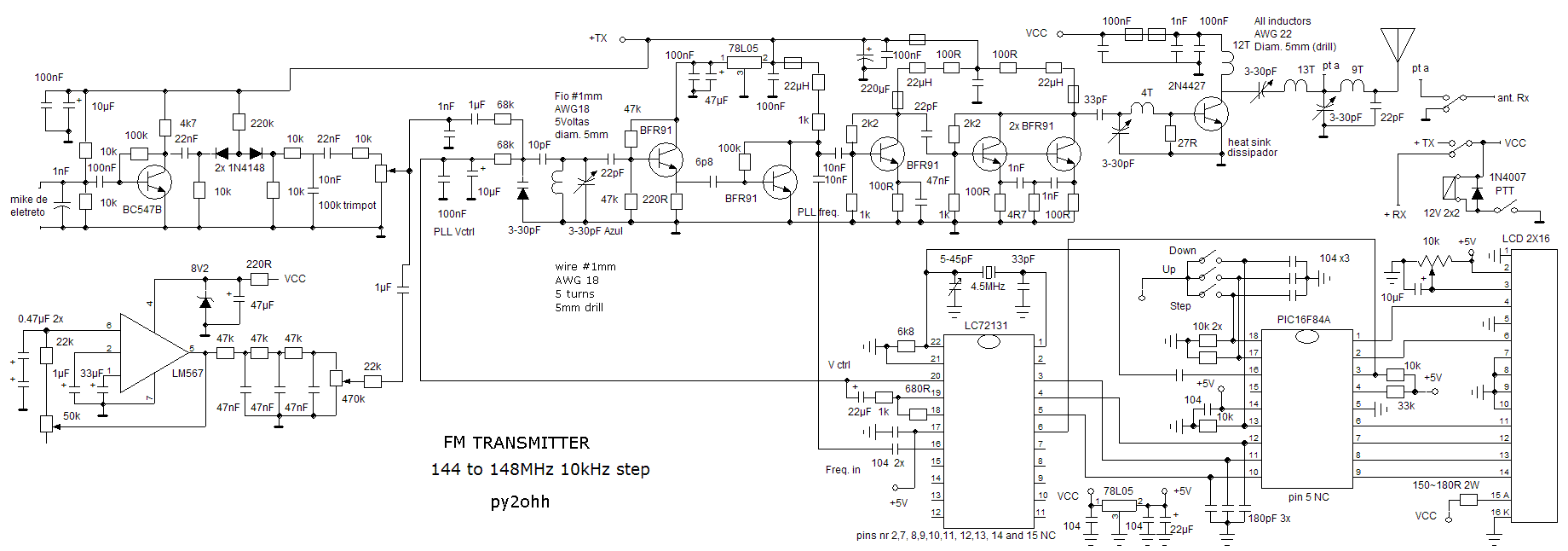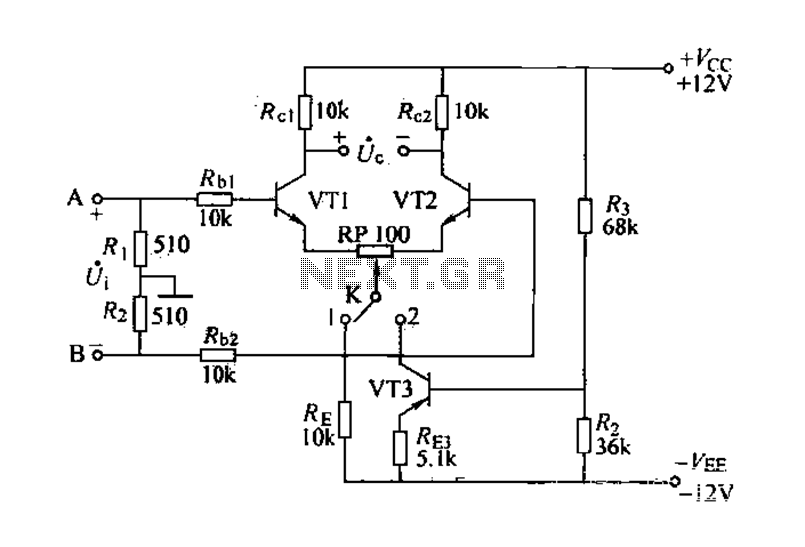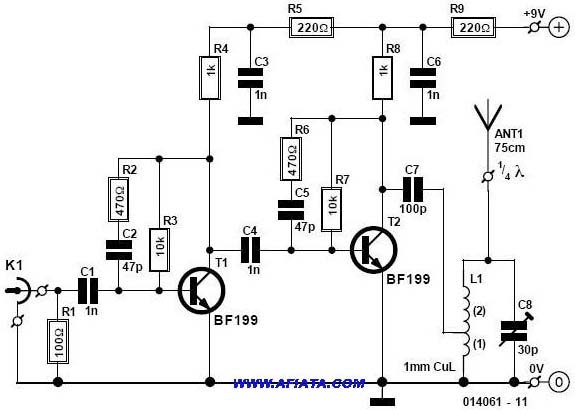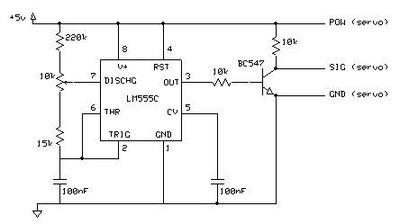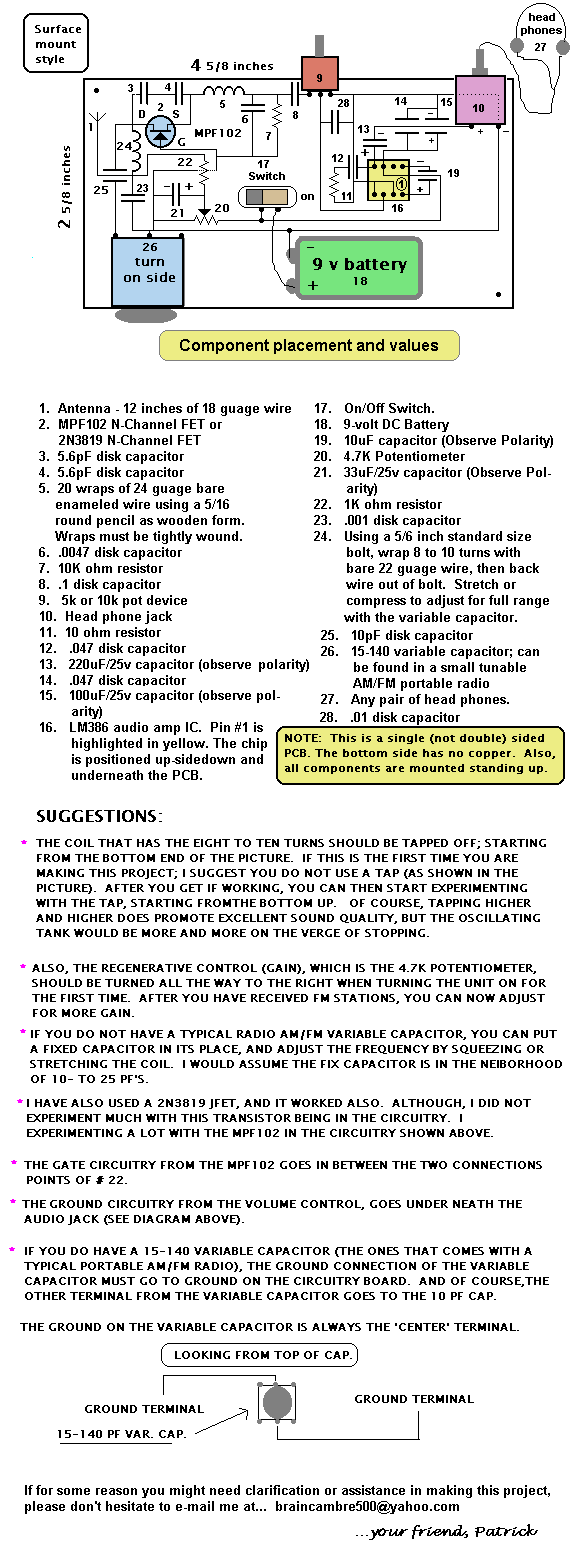
Wien Bridge Oscillator: The Circuit Schematic Diagram and The Design Formula
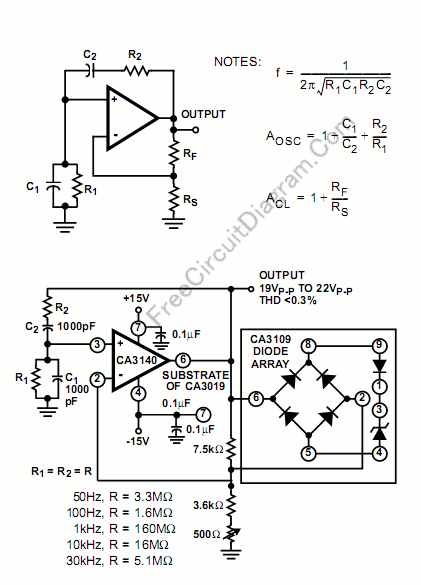
The high input impedance, high slew rate, and high voltage characteristics of the CA3140 operational amplifier make it suitable for use in a Wien-bridge sine wave oscillator. The basic circuit configuration for the Wien-bridge sine wave oscillator is depicted in the accompanying figure. According to the formula presented, when R1 equals R2 equals R, and C1 equals C2 equals C, the frequency can be calculated as f = 1/(2πRC). The gain required for oscillation, denoted as AOSC, is equal to 3. If C2 is increased by a factor of four and R2 is decreased by a factor of four, the gain required for oscillation changes to 1.5, allowing for a potentially higher operating frequency that approaches the gain bandwidth product of the CA3140. The schematic diagram of the circuit illustrates the necessity for oscillation stabilization, which can be achieved through various methods. If the gain is not stabilized, oscillation may either diminish or increase uncontrollably, leading to significant distortion. The feedback element RS is typically substituted with a variable resistance element. Control methods enable dynamic adjustment of RS to maintain a constant oscillator output. Common components for this purpose include thermistors, FET channel resistances, lamp bulbs, or other devices whose resistance increases with output amplitude. Another stabilization method involves using a Zener diode to shunt the feedback resistor, thereby reducing op-amp gain. As the output signal amplitude rises, the Zener diode's impedance decreases, resulting in increased feedback and a corresponding reduction in gain, which stabilizes the output signal amplitude. This method, which employs a combination of a monolithic Zener diode and a bridge rectifier circuit, provides a zero temperature coefficient for the stabilization system. Unlike lamp bulbs, which exhibit a thermal time constant, or RC networks typically used in detector applications, this circuit has no lower frequency limit due to the absence of a time constant in the bridge rectifier system. For instance, utilizing 1 F polycarbonate capacitors and a 22 MΩ frequency-determining network would yield an operating frequency of 0.007 Hz. To avoid slew-rate limitations on the output signal, the amplitude must be reduced as the frequency increases. An output frequency of 180 kHz requires a slew rate of 9 V/s when the amplitude is 16 V peak-to-peak. [Circuit schematic diagram source: Intersil's CA3140 Op-Amp Application Notes]
The Wien-bridge sine wave oscillator circuit utilizing the CA3140 op-amp is a classic design that leverages the op-amp's properties to generate stable sine wave outputs. The circuit consists of a feedback loop that includes resistors and capacitors configured to set the frequency of oscillation. The choice of components directly influences the stability and performance of the oscillator.
In this circuit, the resistors R1 and R2, as well as capacitors C1 and C2, are crucial in determining the oscillation frequency. The relationship f = 1/(2πRC) indicates that both resistance and capacitance values must be selected carefully to achieve the desired frequency. The gain of the op-amp must also be managed to ensure sustained oscillation; this is where the feedback element RS plays a vital role. By employing a variable resistor in place of RS, the circuit can dynamically adjust to changes in output amplitude, ensuring that the gain remains within the necessary range for stable oscillation.
The inclusion of a Zener diode for feedback stabilization offers a robust solution for maintaining consistent output levels. The Zener diode's ability to change impedance with varying output levels provides a natural feedback mechanism that counteracts amplitude fluctuations. This is particularly advantageous in applications where temperature variations or component tolerances might otherwise affect performance.
The design also addresses the slew rate limitations of the op-amp. As the frequency of oscillation increases, the slew rate becomes a critical factor, particularly at higher amplitudes. The circuit's ability to adapt the amplitude in response to frequency changes ensures that the output remains linear and distortion-free.
In summary, the CA3140-based Wien-bridge sine wave oscillator is an effective circuit for generating sine waves with high precision and stability. The careful selection of components, combined with feedback stabilization techniques, allows for versatile applications in signal generation and waveform synthesis.The excellent high input impedance, high slew rate, and high voltage qualities of CA3140 op-amp make it suitable for Wien-bridge sine wave oscillator. The basic circuit for Wien-bridge sine wave oscillator is shown in the figure below (the upper part).
You can see the formula in the figure, when R1=R2=R, and C1=C2=C, then the formula would be a ve ry simple and familiar f = 1/(2piRC), and the gain required for oscillation, AOSC, is equal to 3. If C2 is multiplied by a factor of four and R2 is divided by a factor of four, the gain required for oscillation becomes 1. 5, thus a potentially higher operating frequency closer to the gain bandwidth product of the CA3140 becomes possible.
Here is the circuit`s schematic diagram: The oscillation stabilization should be done, and various methods has been implemented in practice. If this the gain is not stabilized the the oscillation will either diminish or increase until distorted terribly.
The feedback element RS is usually replaced with some variable resistance element. Thus, using some control methods, the value of RS is dynamically adjusted to keep constant oscillator output. A thermistor, a FET channel resistance, a lamp bulb, or other device whose resistance increases as the output amplitude is increased are a few common elements that has been implemented for this purpose.
The lower figure shows another method to stabilize the oscillator using a zener diode which shunt the feedback resistor to decrease the op-amp gain. The zener diode`s impedance will decrease as the output signal amplitude increases, resulting in more feedback with consequent reduction in gain, stabilizing the amplitude of the output signal.
Using this method which employ a combination of monolithic zener diode and bridge rectifier circuit tends to provide a zero temperature coefficient for this stabilization system. Unlike lamp bulb that has thermal time constant or RC network that is usually used in detector networks, there`s no lower frequency limit in this circuit since the bridge rectifier system has no time constant.
As an example, using 1 F polycarbonate capacitors and 22M for the frequency determining network, the operating frequency would be 0. 007Hz. To prevent the output signal from becoming slew-rate limited, the amplitude should be reduced as the frequency is increased.
An output frequency of 180kHz will need a 9V/ s slew rate when its amplitude is 16VP-P. [Circuit`s schematic diagram source: Intersil`s CA3140 Op-Amp Application Notes] 🔗 External reference
The Wien-bridge sine wave oscillator circuit utilizing the CA3140 op-amp is a classic design that leverages the op-amp's properties to generate stable sine wave outputs. The circuit consists of a feedback loop that includes resistors and capacitors configured to set the frequency of oscillation. The choice of components directly influences the stability and performance of the oscillator.
In this circuit, the resistors R1 and R2, as well as capacitors C1 and C2, are crucial in determining the oscillation frequency. The relationship f = 1/(2πRC) indicates that both resistance and capacitance values must be selected carefully to achieve the desired frequency. The gain of the op-amp must also be managed to ensure sustained oscillation; this is where the feedback element RS plays a vital role. By employing a variable resistor in place of RS, the circuit can dynamically adjust to changes in output amplitude, ensuring that the gain remains within the necessary range for stable oscillation.
The inclusion of a Zener diode for feedback stabilization offers a robust solution for maintaining consistent output levels. The Zener diode's ability to change impedance with varying output levels provides a natural feedback mechanism that counteracts amplitude fluctuations. This is particularly advantageous in applications where temperature variations or component tolerances might otherwise affect performance.
The design also addresses the slew rate limitations of the op-amp. As the frequency of oscillation increases, the slew rate becomes a critical factor, particularly at higher amplitudes. The circuit's ability to adapt the amplitude in response to frequency changes ensures that the output remains linear and distortion-free.
In summary, the CA3140-based Wien-bridge sine wave oscillator is an effective circuit for generating sine waves with high precision and stability. The careful selection of components, combined with feedback stabilization techniques, allows for versatile applications in signal generation and waveform synthesis.The excellent high input impedance, high slew rate, and high voltage qualities of CA3140 op-amp make it suitable for Wien-bridge sine wave oscillator. The basic circuit for Wien-bridge sine wave oscillator is shown in the figure below (the upper part).
You can see the formula in the figure, when R1=R2=R, and C1=C2=C, then the formula would be a ve ry simple and familiar f = 1/(2piRC), and the gain required for oscillation, AOSC, is equal to 3. If C2 is multiplied by a factor of four and R2 is divided by a factor of four, the gain required for oscillation becomes 1. 5, thus a potentially higher operating frequency closer to the gain bandwidth product of the CA3140 becomes possible.
Here is the circuit`s schematic diagram: The oscillation stabilization should be done, and various methods has been implemented in practice. If this the gain is not stabilized the the oscillation will either diminish or increase until distorted terribly.
The feedback element RS is usually replaced with some variable resistance element. Thus, using some control methods, the value of RS is dynamically adjusted to keep constant oscillator output. A thermistor, a FET channel resistance, a lamp bulb, or other device whose resistance increases as the output amplitude is increased are a few common elements that has been implemented for this purpose.
The lower figure shows another method to stabilize the oscillator using a zener diode which shunt the feedback resistor to decrease the op-amp gain. The zener diode`s impedance will decrease as the output signal amplitude increases, resulting in more feedback with consequent reduction in gain, stabilizing the amplitude of the output signal.
Using this method which employ a combination of monolithic zener diode and bridge rectifier circuit tends to provide a zero temperature coefficient for this stabilization system. Unlike lamp bulb that has thermal time constant or RC network that is usually used in detector networks, there`s no lower frequency limit in this circuit since the bridge rectifier system has no time constant.
As an example, using 1 F polycarbonate capacitors and 22M for the frequency determining network, the operating frequency would be 0. 007Hz. To prevent the output signal from becoming slew-rate limited, the amplitude should be reduced as the frequency is increased.
An output frequency of 180kHz will need a 9V/ s slew rate when its amplitude is 16VP-P. [Circuit`s schematic diagram source: Intersil`s CA3140 Op-Amp Application Notes] 🔗 External reference
